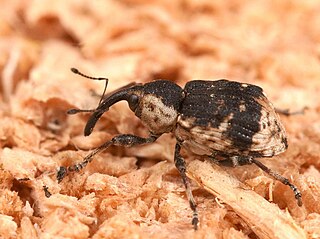
The Curculionidae are a family of weevils, commonly called snout beetles or true weevils. They are one of the largest animal families with 6,800 genera and 83,000 species described worldwide. They are the sister group to the family Brentidae.

Weevils are beetles belonging to the superfamily Curculionoidea, known for their elongated snouts. They are usually small – less than 6 mm in length – and herbivorous. Approximately 97,000 species of weevils are known. They belong to several families, with most of them in the family Curculionidae. It also includes bark beetles, which while morphologically dissimilar to other weevils in lacking the distinctive snout, is a subfamily of Curculionidae. Some other beetles, although not closely related, bear the name "weevil", such as the biscuit weevil, which belongs to the family Ptinidae.

Anthonomus is a genus of weevils. This genus includes major agricultural pests such as the boll weevil, strawberry blossom weevil, and pepper weevil, as well as promising biological pest control agents such as Anthonomus santacruzi.

Otiorhynchus is a large genus of weevils in the family Curculionidae. Many species of the genus, particularly the black vine weevil and the strawberry root weevil, are important pests, both as larvae and as adults. Larvae feed on plant roots. Adults are flightless with fused elytra and feed at night on plant foliage. In many species of the genus at least some races are polyploid and parthenogenetic, while the rest of the races and species are diploid and bisexual. Otiorhynchus weevils, particularly O. scaber, have been a popular subject for studies of the evolution of parthenogenesis. The genus is native to the Palearctic region. However, sixteen species were inadvertently introduced to North America and have become widespread there.

The Entiminae are a large subfamily in the weevil family Curculionidae, containing most of the short-nosed weevils, including such genera as Entimus, Otiorhynchus, Phyllobius, Sitona, and Pachyrrhynchus. In comparison with their stunning diversity, only a few of these weevils are notorious pests of major economic importance. Entimines are commonly encountered in the field, including urban environments, and abundant in entomological collections.

Baridinae is a subfamily of true weevils (Curculionidae). It was established by Carl Johan Schönherr in 1836. Some 4,300 species in 550 genera are placed here, most of which occur in the New World. A few are economically significant pests, while others are in turn used for biocontrol of invasive plant pests. This subfamily also contains a few endangered species.

Rhynchophorus, or common name palm weevils, is a genus of beetles in the weevil family, Curculionidae. Palm weevils are major pests of various trees in the family Arecaceae throughout the tropics including: coconut, Areca catechu, species of the genus Phoenix, and Metroxylon sagu. Two species are invasive pests outside their native ranges, Rhynchophorus ferrugineus and Rhynchophorus palmarum.

Ceutorhynchini is a true weevil tribe in the subfamily Baridinae.

Liparus coronatus is a species of beetles belonging to the family Curculionidae.

Dryocoetes autographus is a species of weevil native to Europe.

Hylesinus fraxini is a species of weevil native to Europe.

Orthotomicus laricis, commonly known as the lesser larch bark beetle, is a species of weevil native to Europe.

Pityogenes bidentatus is a species of bark beetle native to Europe.

Trypodendron domesticum is a species of weevil native to Europe.

Grypus equiseti, known by the common name horsetail weevil, is a species of weevil native to Europe. It feeds on Equisetum arvense and Equisetum palustre plants. It has been introduced to New Zealand to control Equisetum arvense, which is an invasive species there.

Notaris acridulus is a species of weevil native to Europe.

Thryogenes nereis is a species of weevil native to Europe.

Tournotaris bimaculatus is a species of weevil native to Europe.

Pandeleteius is a genus of broad-nosed weevils in the family Curculionidae. There are over 150 described species in Pandeleteius, distributed across the Americas. Most species in the genus were described by Anne Howden.
Perissops ocellatus is a weevil in the Curculionidae family, found on the east coast of Australia in New South Wales and Queensland.



















